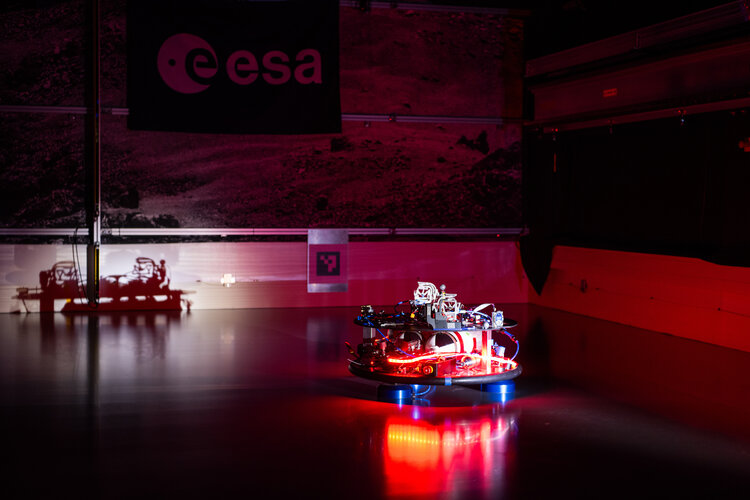Ramon.Space expands to UK to boost space computing development
Wednesday, 17 July 2024 14:44 Ramon.Space, a leader in space-resilient computing infrastructure, has announced the opening of its new subsidiary, Ramon.Space UK. This move marks the company's first office in Europe, underscoring its commitment to advancing space computing and communications worldwide.
The new UK office will act as a key engineering hub, focusing on driving innovation and accelerating advancements in sp
Ramon.Space, a leader in space-resilient computing infrastructure, has announced the opening of its new subsidiary, Ramon.Space UK. This move marks the company's first office in Europe, underscoring its commitment to advancing space computing and communications worldwide.
The new UK office will act as a key engineering hub, focusing on driving innovation and accelerating advancements in sp Zero-G testing on Europe’s flattest floor
Wednesday, 17 July 2024 13:36
A student team testing a new approach to satellite propulsion came to the flattest floor in Europe – based at ESA’s ESTEC technical centre in the Netherlands – which is used to reproduce the experience of weightless free-floating in two dimensions instead of three.
GPS startup bets on advanced signal to counter jamming threats
Wednesday, 17 July 2024 13:00

GOP platform lays out aggressive space agenda to counter China
Wednesday, 17 July 2024 12:00
Satnav enables medical and emergency response
Wednesday, 17 July 2024 08:35
Satellite navigation is not just about travel directions; its applications extend to search and rescue operations, agriculture, autonomous vehicles, sports and perhaps surprisingly, even health. ESA's NAVISP programme supports European companies in the creation of satnav-powered solutions with all sorts of applications – among them, emergency response and healthcare.
Elon Musk says he's moving SpaceX, X headquarters from California to Texas
Wednesday, 17 July 2024 07:20
Billionaire Elon Musk says he's moving the headquarters of SpaceX and social media company X to Texas from California.
Musk posted on X Tuesday that he plans on moving SpaceX from Hawthorne, California to the company's rocket launch site dubbed Starbase in Texas.
Double trouble: Gaia hit by micrometeoroid and solar storm
Wednesday, 17 July 2024 07:00
Launched in December 2013, ESA’s Gaia spacecraft is on a mission to map the locations and motions of more than a billion stars in the Milky Way with extreme precision.
But it’s not easy being a satellite: space is a dangerous place. In recent months, hyper-velocity space dust and the strongest solar storm in 20 years have threatened Gaia’s ability to carry out the precise measurements for which it is famous.
NASA science head optimistic Europa Clipper launches on schedule
Tuesday, 16 July 2024 22:33

Existence of Lunar Lava Tube Confirmed by International Scientists
Tuesday, 16 July 2024 20:03 A team of international scientists, led by the University of Trento, Italy, has made a major discovery about the Moon. For the first time, they have confirmed the existence of a tunnel in the lunar subsurface, likely an empty lava tube. This significant research, published in Nature Astronomy, is the result of an international collaboration.
"These caves have been theorized for over 50 yea
A team of international scientists, led by the University of Trento, Italy, has made a major discovery about the Moon. For the first time, they have confirmed the existence of a tunnel in the lunar subsurface, likely an empty lava tube. This significant research, published in Nature Astronomy, is the result of an international collaboration.
"These caves have been theorized for over 50 yea Next-Gen Weather Satellite Completes Critical Environmental Tests
Tuesday, 16 July 2024 20:03 As climate change drives more frequent and severe weather events, the importance of precise and timely forecasting has grown immensely. The upcoming Meteosat Third Generation weather satellite has successfully completed its environmental testing, marking a significant milestone on its path to launch.
This new series of satellites aims to revolutionize weather forecasting, particularly acro
As climate change drives more frequent and severe weather events, the importance of precise and timely forecasting has grown immensely. The upcoming Meteosat Third Generation weather satellite has successfully completed its environmental testing, marking a significant milestone on its path to launch.
This new series of satellites aims to revolutionize weather forecasting, particularly acro China's All-Electric Communication Satellite APSTAR 6E Now Operational
Tuesday, 16 July 2024 20:03 China's first fully electric communication satellite, APSTAR 6E, officially commenced operation on Monday, announced China Great Wall Industry, the project's contractor.
Launched by a Long March 2C rocket from the Xichang Satellite Launch Center in Sichuan province in January 2023, APSTAR 6E took 514 days to transition from a low-Earth orbit, where it was deployed, to its designated geosyn
China's first fully electric communication satellite, APSTAR 6E, officially commenced operation on Monday, announced China Great Wall Industry, the project's contractor.
Launched by a Long March 2C rocket from the Xichang Satellite Launch Center in Sichuan province in January 2023, APSTAR 6E took 514 days to transition from a low-Earth orbit, where it was deployed, to its designated geosyn Innovative Stochastic Model Revolutionizes Interplanetary Supply Chain Planning
Tuesday, 16 July 2024 20:03 The Beijing Institute of Technology has unveiled a groundbreaking study that seeks to reshape how we plan and manage supply chains between Earth and Mars. Using a Multi-Stage Stochastic Programming (MSP) model, the researchers have addressed the complex uncertainties inherent in interplanetary logistics, providing fresh insights into the infrastructure and operational requirements for supporting
The Beijing Institute of Technology has unveiled a groundbreaking study that seeks to reshape how we plan and manage supply chains between Earth and Mars. Using a Multi-Stage Stochastic Programming (MSP) model, the researchers have addressed the complex uncertainties inherent in interplanetary logistics, providing fresh insights into the infrastructure and operational requirements for supporting Juice's Historic Lunar-Earth Flyby: Key Details
Tuesday, 16 July 2024 20:03 Juice is set to achieve a remarkable milestone with its unprecedented lunar-Earth flyby, the first of its kind. This double gravity assist maneuver is critical for adjusting the spacecraft's trajectory, but it is a complex and high-risk operation.
Since Juice's launch in April 2023, this flyby marks the beginning of its intricate journey towards Jupiter. Earth's gravity will redirect Juice
Juice is set to achieve a remarkable milestone with its unprecedented lunar-Earth flyby, the first of its kind. This double gravity assist maneuver is critical for adjusting the spacecraft's trajectory, but it is a complex and high-risk operation.
Since Juice's launch in April 2023, this flyby marks the beginning of its intricate journey towards Jupiter. Earth's gravity will redirect Juice 



